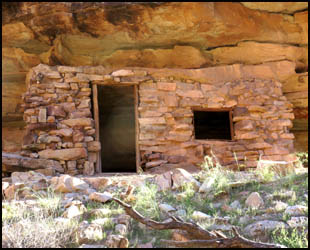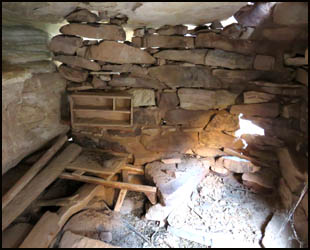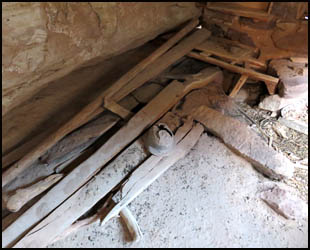BEN BEAMER Tucked into a small cliff of Tapeats Sandstone on the south side of the Little Colorado River at the Confluence, there is a small stone cabin. Part cliff (back wall and part of the ceiling), part human construction, the stone “cabin” that Ben Beamer occupied starting in 1890 was a hybrid structure that took the Ancient Puebloan ruin that he found near the confluence of the Little Colorado River and Colorado River and then remodeled to suit his needs.
Beamer, like many early Grand Canyon miners, sought gold and silver deposits but found copper and asbestos more plentiful. Indeed, asbestos mined from the Grand Canyon was an important resource for its day. Used as a fire retardant, for example, it was used in theater curtains across the United States and as far away as London. Beamer prospected for mineral deposits along the cliffs and side canyons of the river corridor and, following in the footsteps of Ancient Puebloan predecessors, pursued some small scale farming along the bench adjacent to his cabin. Compared to other parts of the Grand Canyon, only a handful of prospectors and miners set up claims in the southeast section of the canyon, an area where pioneers were kept at bay by meager mineral deposits, a lack of European-American settlement, and a deeply entrenched, active Hopi-Navajo cultural sphere. Mormon settlers shifted this human matrix in the southeast canyon as they moved from Utah into the canyon and downstream from Lees Ferry while non-Mormon miners and ranchers shifted northward into the area by the 1870s. Beamer may not have had a large impact on mining claims in the Grand Canyon; however he did help to create a lasting trail network in this vicinity. Beamer hammered a trail out of the coarse grained Tapeats Sandstone that follows closely along the southeast side of the Colorado River connecting his cabin to Palisades Creek and then on to the Tanner Trail. The trail became part of a larger network of trails known as “Horsethief trail” since it was frequently used by more nefarious canyon residents who stole their four-legged freight from south rim outposts then drove them down the canyon along the Tanner and Beamer trails, re-branding the animals while in transit. They repeated their trade network in the opposite direction after emerging from the canyon on the northern side near the Arizona Strip where they sold the animals to Mormon pioneers then collected new horses from their unsuspecting recent customers to drive into the canyon and sell on the southern side. The trail is still in use today. Beamer is one of the few Grand Canyon settlers for whom there is no known picture.
Source material for this story: Anderson, Michael. 1998. Living at the edge: Explorers, exploiters and settlers of the Grand Canyon region. Grand Canyon: Grand Canyon Association. Cline Library, NAU. MAIN INDEX | BACK TO HISTORICAL FIGURES
|


